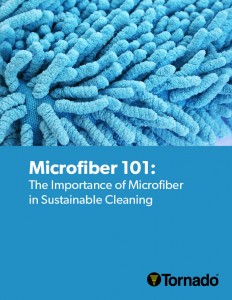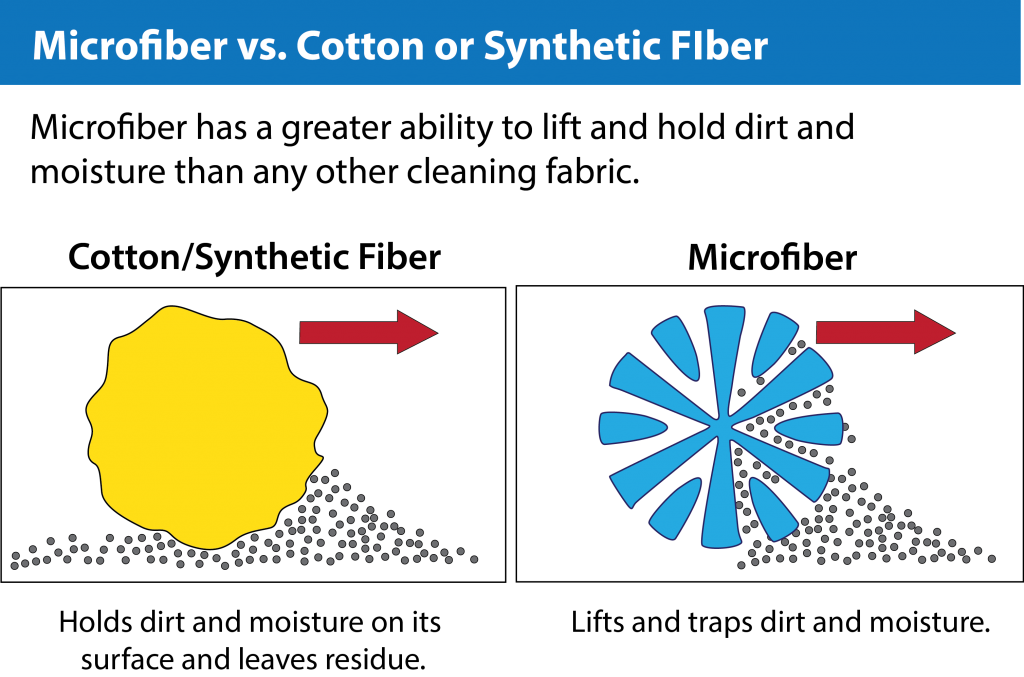Microfiber: The Green Choice
Green cleaning programs are becoming commonplace and, in some parts of the country, even standard practice. More buildings than ever are earning LEED certification from the U.S. Green Building Council, and BSCs are joining the environmental movement in droves. When it comes to “going green,” microfiber plays a critical role.
Made from a polyester-nylon blend, microfiber is incredibly fine fiber—as much as 100 times thinner than a human hair and one-third the diameter of a cotton fiber. It’s very absorbent, able to hold seven times its weight in water, and picks up and removes soil from a surface better than any other product.
In addition to simply cleaning better than cotton, microfiber can contribute to green cleaning in several important ways:
Chemical-free cleaning
Cutting down on chemical usage is a major goal in any green cleaning program because of concerns about pollution, worker safety, and the health of building occupants. In most applications, microfiber and water alone provide an effective clean, thereby eliminating the use of detergents and disinfectants. That’s a huge victory for sustainability. When chemicals must be used, microfiber requires far less to do the job.
Water conservation
Cutting out chemicals in favor of water may sound like it would require more water, but the opposite is actually true. Cleaning with microfiber uses much less water in almost every application, particularly for mopping. Microfiber also requires less water for laundering as it doesn’t require the immediate and frequent washing of a cotton cloth or mop.
Replace paper
Super-absorbent microfiber towels are a useful alternative to rolls of paper towels. A small stack of microfiber cloths can be kept to quickly resolve spill and messes in high-traffic areas that would otherwise require a thick stack of napkins or paper towels, which end up in the landfill.
Waste reduction
The long lifespan of microfiber tools means they need to be replaced less frequently. Instead of changing (and discarding) a cotton mop head or cloth every few months, you may be able to go a year or more before replacing a microfiber product. At the end of the day, this means a smaller footprint for manufacturing, transport, and procurement, and less waste shipped to the landfill.
Better air quality
Indoor air quality is another important concern for most green certification programs, and this is another place where microfiber shines. The enhanced dust-catching power of microfiber is a boon to allergy and asthma sufferers, and can help all of a building’s occupants breathe easier. With conventional dusting, allergens (dust mites, pollens, and mold spores, for example) may be stirred up and drift around the environment. Microfiber captures and removes these irritants from the room entirely.
Ergonomic and health benefits
Worker safety is an often-overlooked part of an environmentally friendly cleaning regime, but ergonomics are stressed repeatedly by the LEED certification guides. Microfiber can help, especially with mopping—a task traditionally fraught with opportunities for injury. Lightweight and requiring less water, microfiber mops more maneuverable and comfortable to use than waterlogged string mops. In fact, mopping with microfiber is so much easier that, cleaning floors with it has become a task assigned to staff on “light work” regimes due to health problems.
Converting your crew or facility to microfiber is not an easy task. The startup costs can be daunting, fixed attitudes can be frustrating, and new training needs can be overwhelming. But as with any new move towards sustainability, education is key. Take advantage of free demonstrations and trainings offered by suppliers to enlighten staff and key decision makers about the benefits of microfiber.
[et_bloom_locked optin_id=”optin_6″]

As Promised
Microfiber forever changed how janitors do their job. This high-tech product makes cleaning faster, easier, and greener. Learn the ins and outs of this game-changing material.
[/et_bloom_locked]


